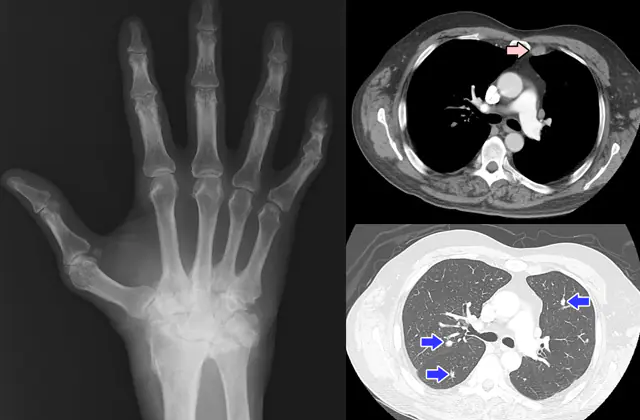
What is bone tuberculosis, causes and symptoms of the disease. Forms and phases, diagnostic methods. Traditional and surgical treatment, folk methods.
The content of the article:- What is bone tuberculosis
- Reasons for development
- Main symptoms
- Diagnostic methods
- Treatment options
- Diet
- Antibacterial and chemotherapy
- Folk remedies
- Surgical intervention
- Orthopedic treatment
- Prevention
Bone tuberculosis is one of the most common forms of the disease after pulmonary tuberculosis. The disease often makes itself felt in adulthood and affects the musculoskeletal system. The pathological process originates in the spine. Therapy takes a long time and uses potent drugs.
What is bone tuberculosis?
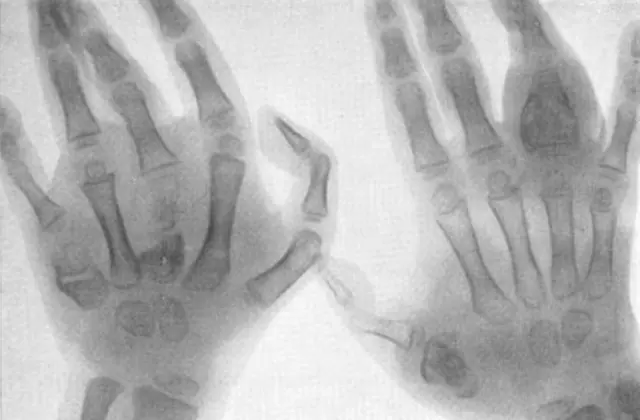
Bone tuberculosis is a disease of infectious etiology, provoked by Koch's bacillus (microbacterium). It affects spongy bone tissue. In the later stages, joint deformation occurs and their mobility is limited. A hump forms on the spine, limbs become shorter or completely immobilized.
Today, the bone form of tuberculosis accounts for 20% of all extrapulmonary cases of the disease and 3.5% of all diagnosed cases of tuberculosis. The mortality rate of patients is almost zero.
There are 3 clinical forms of the disease:
- osteitis or osteomyelitis - the infection affects all parts of the bone, right down to the bone marrow;
- synovitis, arthritis - inflammation of the inner membrane that covers the joint cavity;
- Tenosynovitis is an inflammation of the tendon and its sheath.
Depending on the location of the source of inflammation, forms of bone tissue tuberculosis are distinguished:
- spondylitis - damage to the spine (in 2/3 of cases the thoracic region is infected, less often - the lower back);
- drives - affects the knee joint;
- coxitis - a disease of the hip joint (deformation occurs with subsequent dislocation);
- omartritis - damage to the shoulder joint;
- olenitis - tuberculosis of the elbows.
Lesions of the ankle, wrist joints and long bones are less common. When the ankle or elbow becomes infected, fistulas form. Joint fusion often occurs, which leads to limited mobility.
Tuberculosis of the wrist joint is combined with the knee or elbow form. The infection affects both hands. Damage to tubular bones is typical for children under 3 years of age.
If treatment for tuberculosis is started too late, a number of complications are possible, depending on which area of the musculoskeletal system is affected by the infection:
- formation of purulent foci;
- secondary infection, for example, streptococcus;
- arthritis;
- muscle weakness;
- insufficient cell nutrition;
- limitation of joint mobility;
- bone destruction.
Causes of development of bone tuberculosis
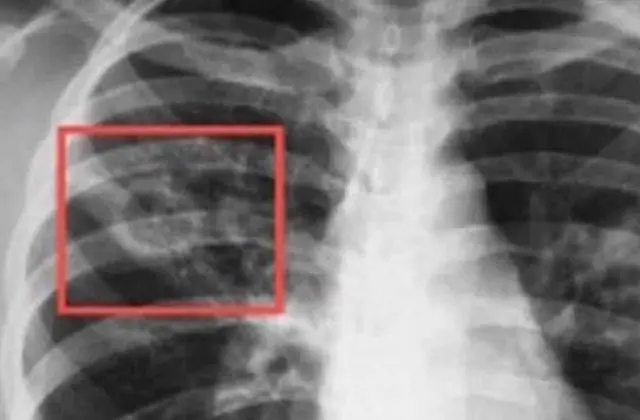
In the photo Koch's bacillus as the causative agent of bone tuberculosis
The main cause of bone tuberculosis in adults and children is infection with Koch's bacillus. This does not require direct contact with the sick person.
To protect yourself from pathology, it is worth knowing how bone tuberculosis is transmitted. You can become infected through unwashed hands and food. If a pulmonary form of pathology is present, bone infection becomes secondary.
But not all people who enter the body with the pathogen develop tuberculosis of the skeletal system. If the immune system is strong, the pathogenic microorganism is eliminated by leukocytes even before penetrating the bone tissue.
There are a number of factors that provoke the development of bone tuberculosis:
- regular hypothermia;
- increased physical activity;
- injuries;
- fasting, poor nutrition;
- complications of other infectious diseases;
- contacts with patients;
- working or living in difficult conditions;
- treatment with immunosuppressants, hormonal drugs;
- regular stress;
- HIV infection.
The presence of one or more of these factors significantly increases the likelihood of developing tuberculosis.
Main symptoms of bone tuberculosis
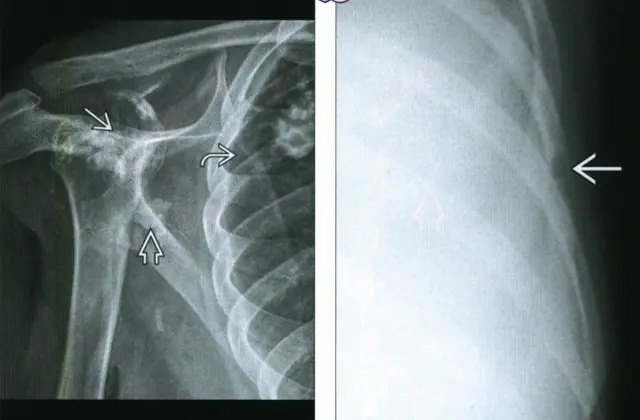
Signs of bone tuberculosis at the beginning of the disease are difficult to notice. The pathology is asymptomatic, sometimes making itself felt by a feeling of heaviness in the lower back, weakness, aching pain in the muscles, which disappear after rest. Patients consider these symptoms to be a manifestation of fatigue and strained back muscles. The first phase is characterized by loss of appetite, autonomic disorders, insomnia, and sometimes an increase in temperature up to 37 degrees.
Children who are subsequently diagnosed with tuberculosis are absent-minded and avoid active games. Sometimes their movements and gait show stoop, raised shoulders, clubfoot, lameness, but there are no injuries.
The first phase lasts from 2-3 weeks to a year, depending on the strength of the patient’s immune system.
The second phase is characterized by the transition of the disease beyond the bone tissue. Signs of bone tuberculosis manifest themselves in the form of severe pain in the joints, spine, limitation of their activity, and muscle stiffness. The temperature rises, the weakness intensifies. Symptoms of intoxication are observed, more pronounced in children.
Symptoms of bone tuberculosis manifest themselves in changes in posture, swelling in the affected area, painful on palpation. A person suffers from regular muscle spasms, and soft tissues gradually atrophy.
If during the second phase an abscess develops and serous or purulent contents are released through the skin, there is a high risk of secondary infection.
If left untreated, the patient's condition worsens, and the symptoms of bone tuberculosis become more acute. A person loses weight, the temperature rises to 40 degrees. The pain becomes unbearable, movements are limited.
If treatment is started on time, the attenuation phase begins. The condition improves, but residual signs of bone deformation remain evident. Timely consultation with a doctor allows you to restore joint mobility and restore the functioning of the musculoskeletal system.
The symptoms described above, characteristic of the 3 phases of tuberculosis, are accompanied by internal changes in bone tissue:
- Primary osteitis. Granulomas (nodules) form in the bone spongy substance due to cell transformation. Gradually they grow and merge, forming foci. The process takes a long time and is asymptomatic.
- Uncomplicated osteitis. Tuberculosis spreads to the joints, affecting the synovial membranes. Pus accumulates in the joint cavity, the cartilage dies, resulting in the exposed surface of the joint. At the end of the second phase, the tissues of the joint capsule die, fistulas and purulent inflammation form. The joints are deformed and destroyed, which affects the length of the limbs.
- Metatuberculous osteoarthritis. This is the name of the attenuation phase of the tuberculosis process, during which the lesions are restored and impregnated with layers of lime. Inflammation is considered to have subsided if the abscesses resolve and become dense.
Knowing how bone tuberculosis manifests itself, you can independently diagnose the disease at an early stage and undergo diagnostics.
Methods for diagnosing bone tuberculosis
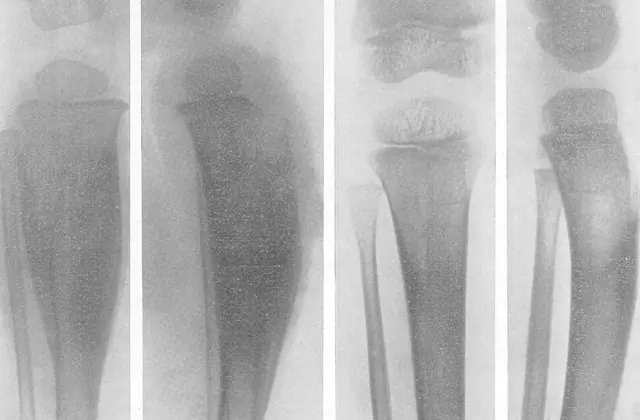
Diagnosis of bone tuberculosis includes x-rays and laboratory tests. At the first symptoms you need to consult a therapist. If suspicions are confirmed, he refers the patient to a phthisiatrician.
The doctor collects anamnesis, examines the affected areas of the musculoskeletal system and makes a preliminary diagnosis based on the following data:
- possible contact with the patient;
- tuberculin test results;
- the presence of acute or chronic infectious diseases;
- the period when the first symptoms were noticed;
- the presence of restrictions in the motor functions of the joints.
When examining the patient, the phthisiatrician evaluates the contours of the affected area, the presence of swelling, the condition of the joints, muscle tone, and pain areas.
X-ray images of tuberculosis clearly show areas of osteoporosis, since lime is actively washed out of the bone tissue and septa. But since in an adult the bones resist destruction for a long time, x-rays do not allow one to accurately determine the phase of the disease.
If x-rays do not make it possible to make a diagnosis, tuberculin tests are taken. Tests for bone tuberculosis include puncture of the affected area. To clarify the diagnosis, MRI, CT, and myelography are performed. A blood test reveals an accelerated ESR, an increase in the number of leukocytes, and C-reactive protein.
Since the symptoms of bone tuberculosis are similar to those of other diseases, differentiated diagnosis with the following pathologies is required:
- rheumatism;
- lesions caused by other pathogens;
- injuries;
- arthrosis;
- oncological tumors.
Summarizing the information received, the phthisiatrician concludes about the presence of Koch's bacillus in the body and the phase of development of the disease.
Methods for treating bone tuberculosis
Treatment of bone tuberculosis takes the patient up to 3 years. It is aimed at increasing immunity, destroying bacteria, and strengthening the body. To determine therapeutic tactics, the phthisiatrician takes into account test results, the phase of the disease, and the patient’s condition. In the acute phase, treatment of bone tuberculosis takes place in a hospital.
Diet for bone tuberculosis

The patient is prescribed a diet rich in protein foods. Since during tuberculosis there is an active breakdown of protein compounds, the body consumes them in large quantities. The daily protein requirement is 100-120 g. If body temperature rises significantly, the norm is reduced to 70 g.
The calorie content of food is increased by 1/3. Dairy products, fish, meat, and eggs are added to the menu. They try to keep the amount of carbohydrate and fatty foods at the same level, since excess leads to obesity.
To saturate bone tissue with calcium, it is recommended to consume dairy products. During antibiotic therapy, more plant foods are included in the diet.
Antibacterial and chemotherapy of bone tuberculosis
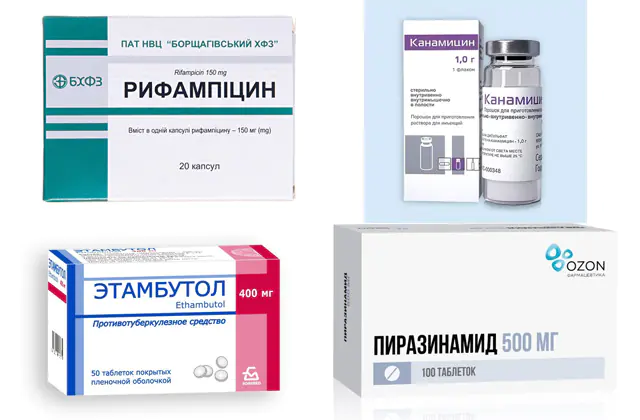
The photo shows drugs for the treatment of bone tuberculosis
How to treat bone tuberculosis depends on the form and phase of the disease. Antibiotic regimens are prescribed by the World Health Organization. They include drugs such as Rifampicin, Kanamycin, Viomycin, Ethambutol (price - 400 rubles or 180 hryvnia). Medicines are administered in the form of intramuscular injections.
During chemotherapy, treatment is carried out with 3 groups of drugs:
- Isoniazid and its analogues: Phtivazid, Metazide;
- preparations based on para-aminosalicylic acid: Ethionamide, Pyrazinamide, Propionamide;
- bacteriostatic anti-tuberculosis drugs: Solutizon, Etoksid (rarely used).
Treatment with these drugs takes place in the hospital of a tuberculosis dispensary. It can be difficult to find medications on the open market: they are purchased with a doctor’s prescription. Oral administration of medications is carried out under the supervision of a phthisiatrician.
To scar the joint capsule and improve the condition of the body, hormonal medications are prescribed (Hydrocortisone, price - 230 rubles or 90 hryvnia).
Folk remedies against bone tuberculosis

Treatment with folk remedies cannot completely get rid of bone tuberculosis, but it will support the immune system and activate the body’s defenses. Traditional medicine recipes are successfully combined with traditional treatment.
The following plants have anti-tuberculosis activity:
- garlic;
- pine pollen;
- juniper;
- aloe;
- vinegar;
- horseradish;
- honey;
- lemon;
- thyme.
All of the above folk remedies are known as powerful natural antiseptics and immunostimulants. Regularly add garlic, lemon to your food, eat sauces with horseradish, vinegar, drink tea with natural honey.
Internally, for the prevention and treatment of tuberculosis, take a water or alcohol infusion of aloe, garlic, thyme decoction, pine and juniper extract.
Surgery for bone tuberculosis
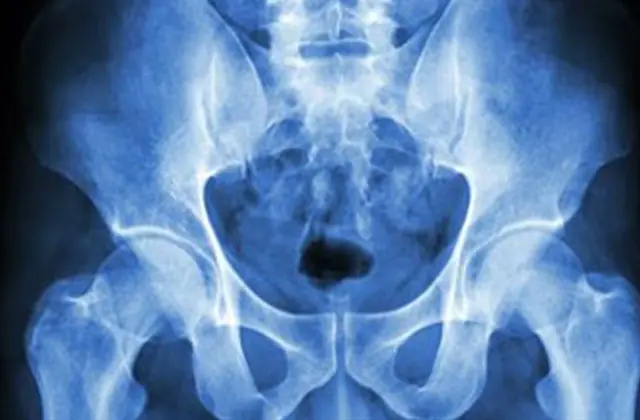
If conservative treatment does not produce results, and the disease continues to progress, surgical methods are turned to combat the consequences of bone tuberculosis. They are aimed at eliminating abscesses, stopping the inflammatory process and returning motor function to the joints.
Radical surgical intervention with removal of the affected lesion (necrectomy, resection) prevents further spread of infection. The advantage of the method is that the removed tissue can be sent for analysis to clarify the diagnosis and treatment program.
Reconstructive surgery or alloplasty is used during the recovery period for damaged joints or removed areas of bone. The missing part is reconstructed using artificial materials.
Endoprosthesis replacement is carried out in case of significant destruction. The bone or joint is replaced with an artificial prosthesis.
Orthopedic treatment of bone tuberculosis

A set of therapeutic measures is aimed at unloading the affected bones and joints. For coxitis and spondylitis, the patient is placed in a plaster bed that follows the shape of the back and covers the neck, head and pelvic bones. If the leg joints are affected, plaster splints are applied.
During the recovery period, if deformed areas remain, the patient wears orthopedic corsets and structures designed for unloading and rehabilitation of the musculoskeletal system.
Important! In the treatment and prevention of bone tuberculosis, bed rest in the acute phase of the disease is of great importance. During the recovery period, the patient is prescribed massage, therapeutic exercises, air and sun baths. It is necessary to walk longer in the fresh air and give the muscles feasible physical activity.Prevention of bone tuberculosis

The prognosis for the treatment of bone tuberculosis is positive. 50% of patients become disabled because deformities remain to varying degrees. Lameness and contractures (inability to fully straighten or bend a joint) develop more often.
Prevention of bone tuberculosis includes a number of measures aimed at preventing the disease:
- reducing contact with patients;
- prevention of regular hypothermia;
- improving living conditions and nutrition;
- vaccination in infancy (BCG) and Mantoux test;
- attention to any changes in the state of the body;
- timely and effective treatment of infectious diseases.
If these measures are observed, the immune system is strengthened, which creates reliable protection against tuberculosis.
The development of medicine makes it possible to cope with even severe forms of bone tuberculosis. In order for the treatment to be successful, it is important to contact a phthisiatrician on time and get tested.
How to treat bone tuberculosis - watch the video:



